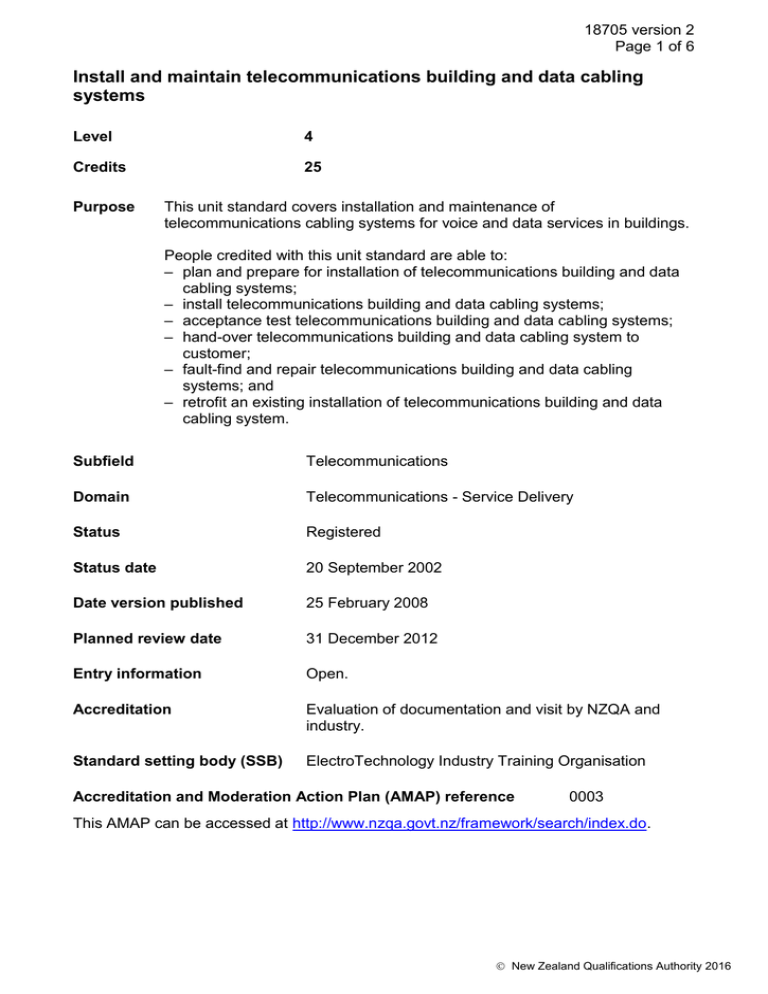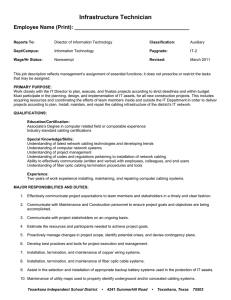Install and maintain telecommunications building and data cabling systems
advertisement

18705 version 2 Page 1 of 6 Install and maintain telecommunications building and data cabling systems Level 4 Credits 25 Purpose This unit standard covers installation and maintenance of telecommunications cabling systems for voice and data services in buildings. People credited with this unit standard are able to: – plan and prepare for installation of telecommunications building and data cabling systems; – install telecommunications building and data cabling systems; – acceptance test telecommunications building and data cabling systems; – hand-over telecommunications building and data cabling system to customer; – fault-find and repair telecommunications building and data cabling systems; and – retrofit an existing installation of telecommunications building and data cabling system. Subfield Telecommunications Domain Telecommunications - Service Delivery Status Registered Status date 20 September 2002 Date version published 25 February 2008 Planned review date 31 December 2012 Entry information Open. Accreditation Evaluation of documentation and visit by NZQA and industry. Standard setting body (SSB) ElectroTechnology Industry Training Organisation Accreditation and Moderation Action Plan (AMAP) reference 0003 This AMAP can be accessed at http://www.nzqa.govt.nz/framework/search/index.do. New Zealand Qualifications Authority 2016 18705 version 2 Page 2 of 6 Special notes 1 This unit standard has been developed for learning and assessment in the workplace. 2 The term building and data cabling systems refers to telecommunications cabling systems in buildings, and includes the more complex systems and testing techniques. 3 In contrast to the level 3 Unit 17486, Install and maintain basic telecommunications building and data cabling, where trainees primarily work with, and have responsibility for, the items of cabling and equipment in their immediate vicinity, and under direct supervision, this level 4 unit standard is concerned with the ability to encompass larger, more complex entities or systems. For this unit standard, the individual components may be separated by some distance; testing will include system or endto-end tests; the work is without direct supervision; there may be supervision of others and responsibility for their work. Ability to work with this larger focus is a critical aspect of assessment against this unit standard. 4 References AS/NZS 3080:2003: Telecommunications installations – Generic cabling for commercial premises; Building Act 2004; Electricity Act 1992; Electricity Regulations 1997; Health and Safety in Employment Act 1992, and associated regulations; any applicable company safety and health procedures; Telecommunications Act 2001; Local Body regulations; and all subsequent amendments and replacements. 5 Definitions Industry practice – those practices, which competent practitioners within the industry recognise as current industry best practice. Regulatory requirements – the requirements of relevant legislation and local body bylaws. Retrofit installation – retrospective installation of telecommunications equipment in an existing building. Specifications – any or all of – detailed job specifications, drawings, and instructions; manufacturers’ specifications and instructions; and industry codes of practice relating to the type of cabling system being installed. UTP – unshielded twisted pair cable, connectors and cabling accessories complying with Category 5, Category 5E, or Category 6 standards. 6 Underpinning knowledge for this unit standard is covered by Unit 17397, Demonstrate knowledge of basic concepts of telecommunications; Unit 17492, Demonstrate basic knowledge of telecommunications building and data cabling; and Unit 18706, Demonstrate knowledge of telecommunications building and data cabling systems. New Zealand Qualifications Authority 2016 18705 version 2 Page 3 of 6 7 Range a The phrase in accordance with current industry practice is implicit in all performance criteria in this unit standard. b Customers may be internal or external to the organisation and may include end users and clients. c Building cabling systems – evidence is required of installation of four building cabling systems involving buildings with more than one floor. d Data cabling systems – evidence is required of four local area networks, including UTP and fibre cables. The data cabling may be combined with the building cabling system. e All work assessed against this unit standard must comply with the requirements of the Health and Safety in Employment Act 1992, relevant regulations, and applicable site and company occupational safety and health procedures. f The installer is to be supplied with design specifications and/or detailed instructions regarding the installation. Installation excludes system design or layout, contract negotiations, or commissioning and operational configuration adjustments required in complex network installations. Elements and performance criteria Element 1 Plan and prepare for installation of telecommunications building and data cabling systems. Performance criteria 1.1 Evaluation of job contract, job specification, time lines, and discussion with customer establish the scope and timing of the installation work. 1.2 Installation plan is developed in terms of available resources, required materials, timing, and site access, and details are agreed with customer. 1.3 All site occupational safety and health implications for self and others are identified, and hazard control measures put in place. 1.4 Materials are purchased or drawn from stock, and delivered to site, in accordance with company practice. Element 2 Install telecommunications building and data cabling systems. Performance criteria 2.1 The fitting, mounting, location, and positioning of hardware is in accordance with specifications and industry practice. Range typical hardware – cable trays, ducting, terminating blocks, cabinets, frames, connectors, catenary wiring. New Zealand Qualifications Authority 2016 18705 version 2 Page 4 of 6 2.2 Earthing, bonding, and protection is in accordance with specifications and industry practice. 2.3 System is installed in accordance with specifications and industry practice. 2.4 Cables are terminated and labelled in accordance with specifications and industry practice. 2.5 Fire-stopping meets regulatory requirements. 2.6 Documentation of installation progress is maintained in accordance with company requirements. 2.7 Drawings are marked up to reflect the as-built situation. 2.8 Sites are restored to customer expectations following completion of installation. Element 3 Acceptance test telecommunications building and data cabling systems. Performance criteria 3.1 Visual inspection confirms that all specified items have been installed as per specification. 3.2 Testing confirms that all cables interconnect to the specified terminations, and that the performance of the system meets the specified standards and any discrepancies are resolved. 3.3 Test results are recorded in accordance with specifications and customer and/or company requirements. Element 4 Hand-over telecommunications building and data cabling system to customer. Performance criteria 4.1 The system is made available to the customer by the agreed date, and, in cases where it impacts upon a network or larger system, plans for the commissioning are agreed with the customer. 4.2 Customer is advised of demarcation and administration points, and issues and options regarding ownership and maintenance of the system. New Zealand Qualifications Authority 2016 18705 version 2 Page 5 of 6 4.3 Support materials are supplied to customers at hand-over in accordance with contract and company requirements. Range 4.4 typical support materials – as-built drawings, performance certification, test results, maintenance materials, product leaflets and instructions, testing instructions, troubleshooting guides. Hand-over documentation is completed in the agreed format, in accordance with customer and company requirements. Element 5 Fault-find and repair telecommunications building and data cabling systems. Performance criteria 5.1 Observations and measurements are interpreted logically and lead to the location of faulty cable or components. 5.2 Faulty cable and/or components are repaired to industry standards or replaced with same or equivalent items. 5.3 Testing confirms restoration to full service. 5.4 Sites are restored to customer expectations following completion of repair work. 5.5 Customer is advised of restoration of service, and records are completed in accordance with customer and company requirements. Element 6 Retrofit an existing installation of telecommunications building and data cabling system. Performance criteria 6.1 Project documentation, site survey, and/or discussions with customer or project engineer is used to establish the scope of the retrofit. 6.2 Inspection and testing verifies extent and quality of existing facilities and confirms their suitability for the new project. 6.3 Faulty cables and terminations are identified and repaired or taken out of service as required by project instructions. 6.4 Redundant cables and terminals are removed and disposed of in accordance with industry practice and project instructions. 6.5 Documentation is completed in accordance with project and company requirements. New Zealand Qualifications Authority 2016 18705 version 2 Page 6 of 6 Please note Providers must be accredited by NZQA, or an inter-institutional body with delegated authority for quality assurance, before they can report credits from assessment against unit standards or deliver courses of study leading to that assessment. Industry Training Organisations must be accredited by NZQA before they can register credits from assessment against unit standards. Accredited providers and Industry Training Organisations assessing against unit standards must engage with the moderation system that applies to those standards. Accreditation requirements and an outline of the moderation system that applies to this standard are outlined in the Accreditation and Moderation Action Plan (AMAP). The AMAP also includes useful information about special requirements for organisations wishing to develop education and training programmes, such as minimum qualifications for tutors and assessors, and special resource requirements. Comments on this unit standard Please contact the ElectroTechnology Industry Training Organisation reviewcomments@etito.co.nz if you wish to suggest changes to the content of this unit standard. New Zealand Qualifications Authority 2016


